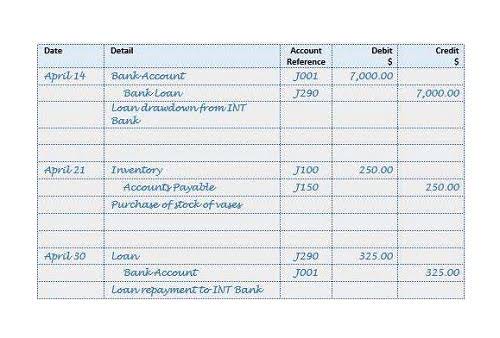
Retained earnings are a big deal when looking at a company’s financial reports. They tell us if a business is making good profits and has a healthy financial situation. By checking the retained earnings, people involved with the company can see how well it’s doing and whether it might grow more prominent. It is the beginning of the operation wherein the current period’s retained earnings are determined. Take this as an account balance that reflects how much profit the company kept in the past.

Subscribe to Taxfyle
- Unlike big corporations, small businesses often rely more on retained earnings for flexibility.
- This table shows how a company would calculate retained earnings over the course of three years.
- Retained earnings also show how much profit has been reinvested in the company over time.
- It’s like the porridge that Goldilocks chose – not too hot, not too cold, but just right, especially if your inventory items are pretty much identical.
- Retained earnings are crucial for small business owners because they provide a source of internal funding.
- Show shareholders the company’s profitability and reinvestment decisions.
Other times, corporations may decide to distribute additional shares of their company’s stock as dividends. This is known as stock dividends, as they issue common shares to existing common stockholders. When a business decides to distribute some of its earnings to shareholders, it issues dividends in the form of either cash payments or shares of stock. Dividends are paid out of accumulated retained earnings, so you’ll need to subtract them from the sum of net income and beginning retained earnings to find the total for your defined period.
- Accounting professionals that want to advance their skills and prepare for career progression should explore their options with a Yeshiva University online Master’s in Accounting degree.
- To calculate retained earnings, you’ll need the beginning retained earnings balance as well as the net income and dividends paid for the reporting period.
- If you’ve ever wondered where a company’s profits go after all the bills are paid, you’re about to discover one of the most important financial concepts in business.
- It’s a measure of the resources your small business has at its disposal to fund day-to-day operations.
- This accumulated profit can be used for various purposes such as research and development, debt reduction, or equipment replacement, contributing to the company’s growth and financial health.
How to Calculate Retained Earnings + Examples
When it comes to ending inventory, precision isn’t just a lofty goal – it’s the key to a robust business health. Precision in calculating your ending inventory means you have a clear view of your current assets, which informs everything from budgeting to strategic planning. Calculating ending inventory is an advantageous practice for businesses, particularly in the eCommerce sector, and a vital step in the accounting process. If your product prices are on a rollercoaster ride, FIFO tends to inflate your ending inventory value. That’s because you’re selling off the old stock at historic costs and keeping the shiny, newer inventory on the books. Think of it as having unsold units valued at current, possibly higher, prices, giving stakeholders the thumbs up regarding the state of your inventory.
- We can cross-check each of the formula figures used in the retained earnings calculation with the other financial statements.
- Suppose a company doesn’t believe its retained earnings can earn a sufficient return (that is, more than its cost of capital).
- On the other hand, negative retained earnings impact shareholders negatively.
- Retained earnings provide a much clearer picture of your business’ financial health than net income can.
- Basically, you take your beginning capital, add your netincome and deduct the withdrawals to determine your endingcapital.
Income Statement
However, some companies with long-standing profitability may occasionally report negative retained earnings. This just means the Outsource Invoicing company decided to pay out more than it reported in profits. Startups and smaller, growth-focused companies tend to have high retention ratios. Large companies that are already profitable and comfortable paying dividends will have a lower ratio. Company XYZ has reported figures for a three-month period ending February 28, 2025 (figures are in thousands of dollars). While calculating retained earnings of this company, assume the beginning retained earnings balance is $0.
The Importance of Retained Earnings

Retained earnings are part of the businesses balance sheets, and they reveal the overall health of the business. Retained earnings serve as a financial cushion for the company, providing a source of funding when the business faces economic downturns or wants to expand its operations. Save time with automated accounting—ideal for individuals and small businesses.
Steps to Calculate Ending Inventory Using FIFO
Subtract what you sold from what you started with plus what you bought, and voilà, you’ve got your ending inventory. By using the above-given data, do the calculation using ending re formula all three methods. Apple’s strategy shows how retained earnings can drive growth and create value when used effectively. For more on why the balance sheet doesn’t always tell the full story, check out our guide on primary limitations of the balance sheet.

This is the amount of cash you have at the start of the period you’re considering. I learned this the hard way working with a local retailer who kept “phantom stock”, items their system said were available but were long gone. That $40,000 represents the current value of the goods you still have in stock. This number will carry forward as your beginning inventory for the next period.


If they don’t, you risk overselling, or worse, running out of your best sellers right before the holidays. If you’ve ever opened your warehouse management system (WMS) and seen numbers that don’t match what’s physically in front of you, congratulations, you’ve experienced the joy of inventory variance. Enter your values below to calculate your ending inventory instantly. Thus we can see the value of the Inventory is affected to a large extent by the method of valuation that the business in question adopts. Do the ending inventory Calculation retained earnings balance sheet under the LIFO, FIFO, and Weighted Average Cost Method.